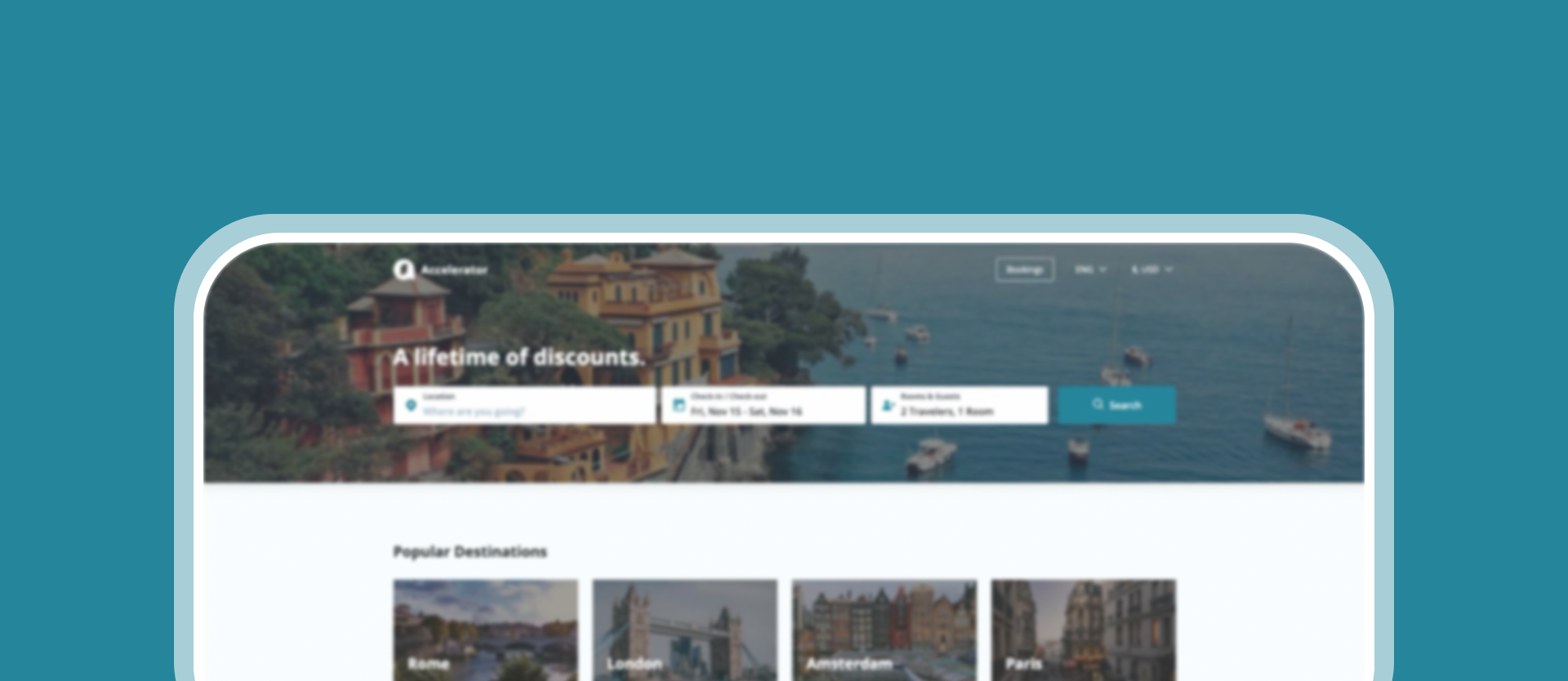A booking engine is as smart as you make it
Our years of experience in building booking engines led us to create a set of essential components to help our partners accelerate their development. These foundational pieces take around six months of work hours to complete and handle the capabilities every booking engine requires.
This article will share the practical lessons we’ve learned along the way, focusing on the best approaches to building the key components.
Below, you can try an interactive widget of our booking engine core framework, Accelerator, to test out the search and booking experience.
Try Our Framework for Booking Engine Development
What is a booking engine?
A booking engine serves as a bridge between travelers and suppliers. It handles customer search requests through user interfaces and connects to travel providers (hotels, airlines, car rentals, etc.) to manage their inventory.
A booking engine makes it possible for travelers to access real-time inventory and make reservations while enabling suppliers to control their offering presentations.
Read our article about travel booking engines to learn in detail about key functions, integrations, and different business models.
Key components of a travel booking engine
We'll use the architecture of AltexSoft’s Accelerator to explain the components fundamental to any engine. Note that our booking engine framework is OTA-focused, so an internal booking engine for a hotel, for example, may approach things a bit differently.
Obviously, every business has its unique needs, so we created a flexible foundation that our partners can customize, whether they’re starting with hotels or expanding to other travel services.
“Our development team intentionally designed the booking engine framework to be adaptable for future enhancements. Rather than creating a solution exclusively for hotels, we built modular components that could be repurposed or extended for other travel services like flights,” Volodymyr Liubashenko, AltexSoft software engineer, shares. “Though certain custom changes will still require modifications on the backend, as the frontend components are significantly more reusable.”
This approach makes the system flexible enough to handle additional functionalities and accommodate future business opportunities with minimal disruption.
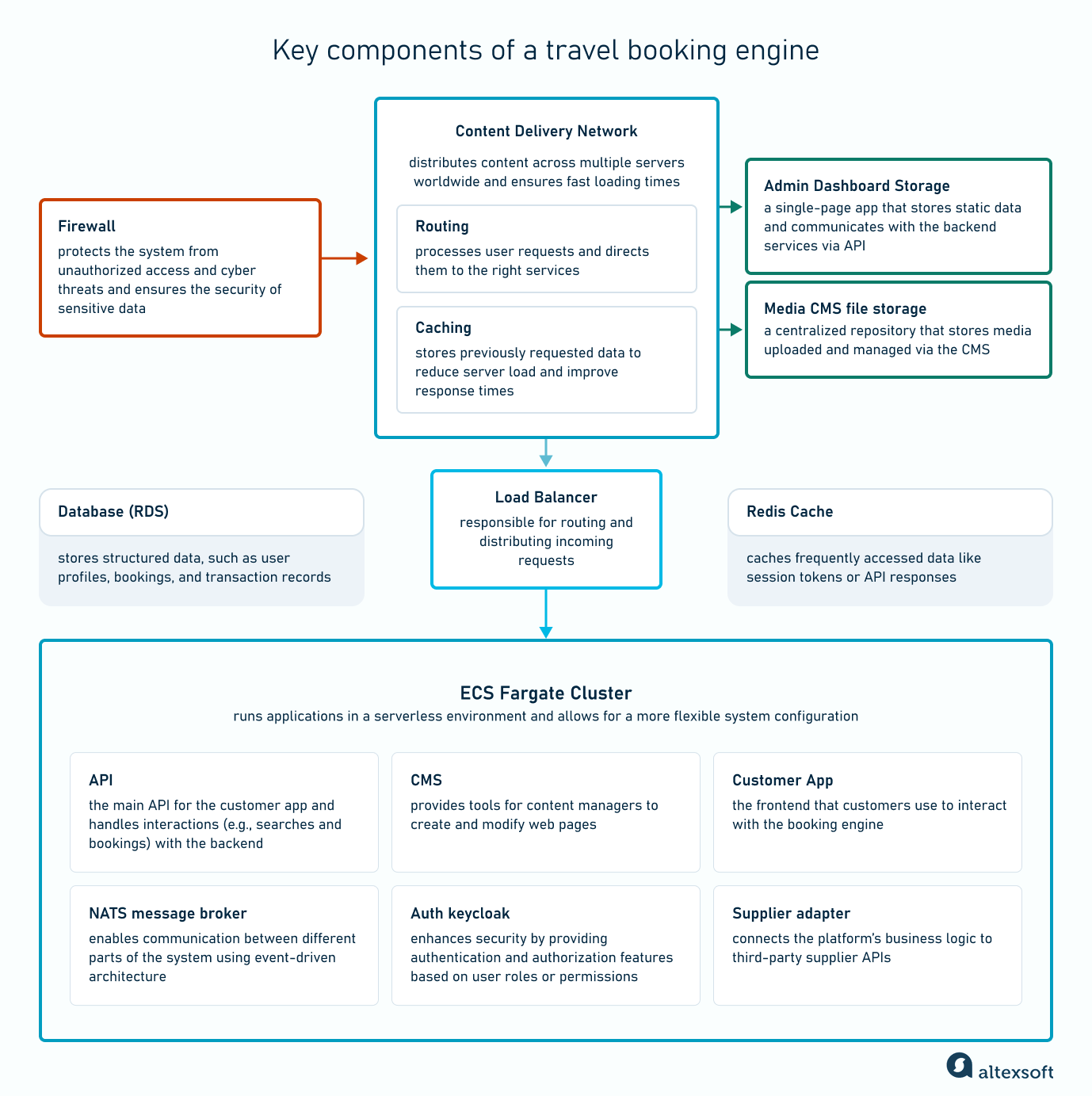
Key components of a travel booking engine
Content delivery network (CDN) and load balancer
Booking engines often serve a high volume of users, especially during peak travel seasons. A server can become overwhelmed by a large number of simultaneous requests, straining its resources and leading to performance degradation or even service crashes.
A content delivery network (CDN) reduces latency by allowing users to receive content from the server nearest to their physical location. It stores and delivers content through a network of geographically dispersed servers.
This is possible due to routing, which processes user requests and directs them to the server that is best suited to deliver that content based on geographic distance and network conditions. Caching also helps improve response times by storing previously requested data.
While the CDN ensures that content is delivered from the nearest server to reduce latency, a load balancer distributes traffic evenly so that no single server becomes overwhelmed. If one server fails, the load balancer immediately shifts the traffic to the other functioning one.
Firewall
Any unprotected system is vulnerable to a range of risks, from unauthorized access and data breaches to malware and cyberattacks. To protect against these threats, we implement a firewall—a dedicated security barrier.
For this service, we use AWS WAF (Web Application Firewall), which monitors incoming HTTP(S) requests to detect suspicious activity. It allows you to define rules to filter web traffic based on various conditions, such as IP addresses, request headers, HTTP body content, geographical location, malicious SQL code, custom URIs, and more.
Content management system (CMS)
We've seen that many businesses starting with booking engines underestimate how often content needs to be adjusted, such as adding text, images, or promotions. Their main mistake is assuming these updates rarely happen and can simply be handed off to developers. This might be manageable for a few first times, but eventually, you'll find yourself waiting on developers to make all the changes.
This is where a content management system (CMS) comes in handy. It provides a user-friendly admin panel where nontechnical teams, such as marketing or content managers, can modify static content, add new pages to the menu, update logos, and more.
"Travel companies often don't prioritize a CMS from the start and view it as a feature that doesn’t justify the investment," Oleksii Taranets, a solution architect at AltexSoft, shares. "However, as time goes on, they experience the challenges of constant content updates. For example, delays negatively impact marketing campaigns or any time-sensitive updates."
Our Accelerator includes a headless CMS for even more simplified travel content management. It is backend-only and provides content via APIs to be presented across platforms. This means the frontend design is separate, and you can adjust content without disrupting any of the booking engine’s functionality.
Relational database and Redis Cache
We store all the structured data (e.g., user profiles, bookings, transaction records, etc.) in a relational database. Its structure allows us to quickly retrieve, update, and manage data across multiple related tables. For example, a single user’s booking history can be linked directly to their profile, the inventory of rooms or flights, and associated payments.
To hold frequently accessed data (e.g., session tokens, API responses, or popular search results), we use Redis Cache. It keeps data in temporary or random access memory (RAM) for quick retrieval.
AltexSoft engineers prefer Redis because it has proven to be a reliable and flexible solution for building caching systems. “There was a project where we achieved a response time of under one second while storing nearly two billion entities in the Redis database,” Oleksii Taranets shares. “It is a very powerful caching solution that can support advanced data structures.”
ECS Fargate by AWS
Traditionally, when running containerized applications, you needed to provision a cluster of servers and manage their lifecycle. This included scaling, patching, networking, and security. To eliminate this burden, we opted for ECS Fargate by AWS. It is a serverless compute engine that handles the infrastructure on your behalf, including server management, resource allocation, and scaling.
“We also considered Kubernetes at the start but landed on Fargate,” Oleksii Taranets shares. “Kubernetes requires much more effort in terms of infrastructure management. Though it offers the reserved instances billing method (where you get a discount in exchange for a long-term commitment), Kubernetes still turned out to be more expensive than Fargate, which offers pay-as-you-go pricing.
"Moreover, AWS service updates can introduce incompatibilities with software in your cluster, and we’ve faced this firsthand — our Kubernetes cluster was down for four hours because of it.”
Here are the components our Fargate cluster hosts:
- customer app (the frontend that customers use to interact with the booking engine);
- the main API for the customer app that handles interactions (e.g., searches and bookings) with the backend;
- the CMS;
- authentication service Auth Keycloak;
- NATS message broker (uses event-driven architecture to enable communication between different parts of the system); and
- supplier adapter (connects the platform’s business logic to third-party supplier APIs).
Now that we’ve broken down the main components of a booking engine, let’s move on to practical advice from AltexSoft specialists who have hands-on experience building these systems. We’ll explore a range of topics, from speed optimization to supplier integrations.
Optimize the loading speed and reduce API calls with caching
No matter how sophisticated your booking engine’s features are, if it takes longer than 3 seconds to load, users will abandon you in favor of a faster alternative.
Implementing efficient caching is a way to optimize your system for speed on all devices. For example, it can speed up the search process by avoiding the need to go through the same flow multiple times.
Here’s how it works. When a user makes a search request, the system generates a cache key that uniquely represents the full context, including destination, travel dates, and number of travelers. Even the location where the search request was made matters, as pricing rules may vary by region. This means that users in different countries will see different offers even if their search criteria are otherwise identical.
Once the key is generated, the system checks if a matching result already exists in the cache. If it does, the result can be returned instantly. If the match isn’t found (either because the request is new or the cache entry has expired), the system performs the standard search and stores the result in the cache for future use.
This also helps reduce the number of API calls. The thing is, suppliers often impose request limits, and exceeding them can lead to fees or penalties. So caching not only speeds up response times but helps you stay out of trouble with suppliers.
While we’re at it, let's talk about smart cache management as well. It is critical to clear it timely, for example, when a business changes some conditions of a live marketing campaign. Now, all the data related to this campaign must be cleared so that users only see the latest version.
You also want to ensure that the cache can be cleared partially. Imagine a customer searching for flights and choosing the cheapest one out of 200 options, but it turns out to be sold out. The user then goes back to the search results to select another flight and now sees the cached options.
We must clear the cache to prevent the customer from choosing that sold-out flight again. Instead of clearing all 200 cached options (which would trigger a new, unnecessary request to suppliers), we can remove only the one we need and return the rest of the 199 options.
Simplify localization with a CMS and pay attention to language specifics
Any program lacking localization creates a confusing and frustrating experience for international users. They may struggle to navigate an interface not in their language, misunderstand critical information like prices, travel dates, or cancellation policies, or feel a lack of trust if local payment methods and currencies aren't supported.
Localization in booking engines goes beyond translating the text and involves adapting the user experience to match the currency, payment methods, data formats, measurement units, legal requirements, and more. It includes interface elements of a booking engine (e.g., buttons, menus, and messages), as well as static content such as hotel names and descriptions.
Ideally, you would get localized static content from suppliers. Unfortunately, that is not always the case. To address this issue, we recommend integrating a service like GIATA, which offers hotel descriptions in 25 languages.
On the other hand, interface localization begins at the code level as developers prepare the system to support certain languages. These settings can later be stored in configuration files.
“A CMS simplifies localization by allowing you to make changes in the UI and display appropriate content for specific regions,” Volodymyr Liubashenko explains. “You can manage multiple customized pages under a single routing path.” Put simply, if a user from Spain visits the site, the CMS automatically routes them to a page with Spanish content.
It’s worth noting that localization might require adjustments to your booking engine's UI. For instance, languages like Arabic and Hebrew are read from right to left (RTL). This means input fields, headings, and buttons should all be aligned to the right.
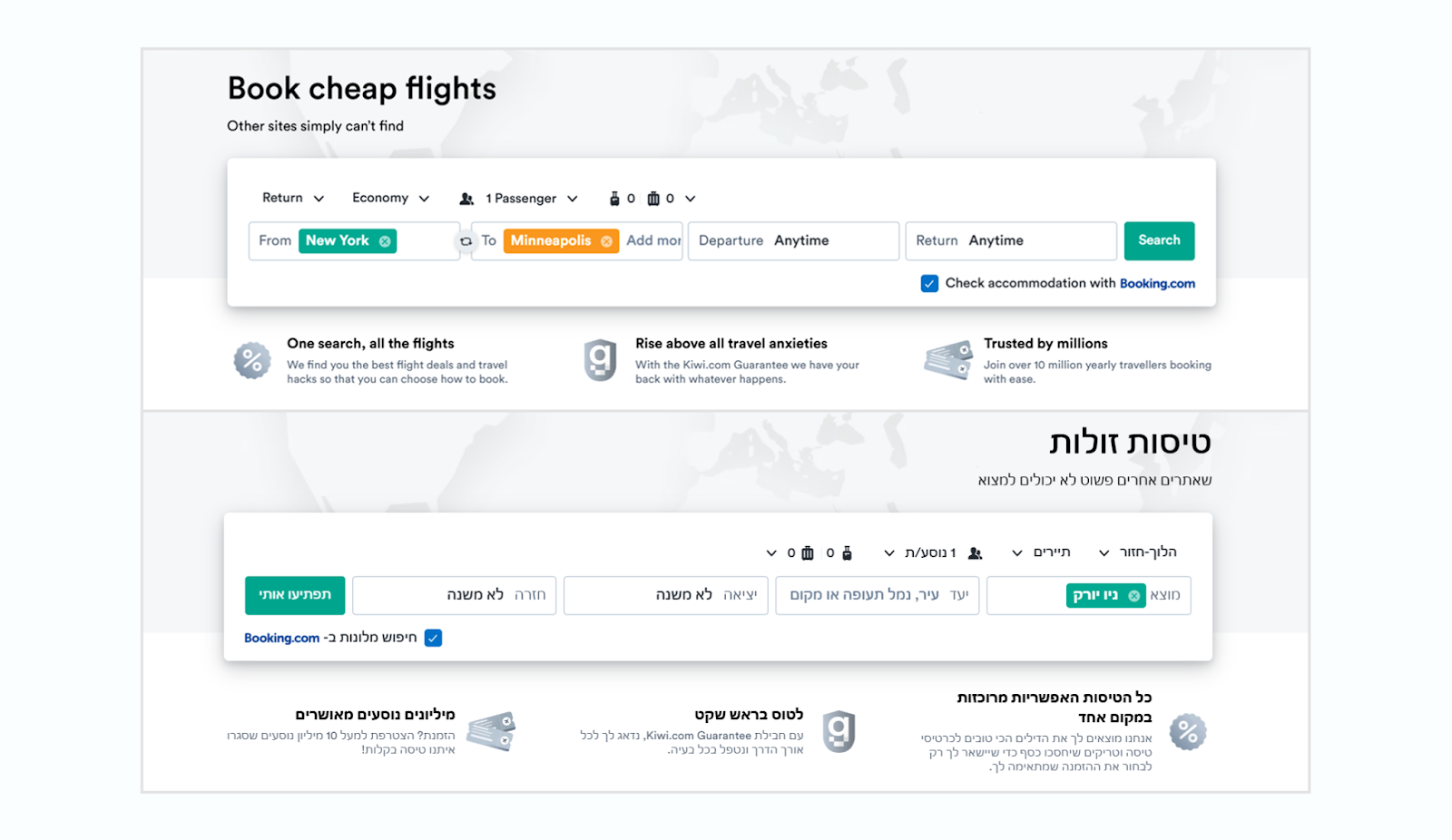
The difference between the interfaces in English and Hebrew languages. Source: Kiwi.com
Even small elements, like the direction of the next arrow icon in a photo gallery, should be flipped to the left for RTL languages. These thoughtful adjustments ensure a smooth user experience and show cultural awareness.
Use a third-party hotel mapping solution
Hotel content mapping is a process of merging property IDs and other content from different sources. Without proper mapping, the same hotel or room can appear multiple times with slight variations in name or other details, leading to a frustrating user experience. Worse, incorrect room information can result in booking errors, customer complaints, and even financial losses due to mismatches between the actual data and the displayed options.
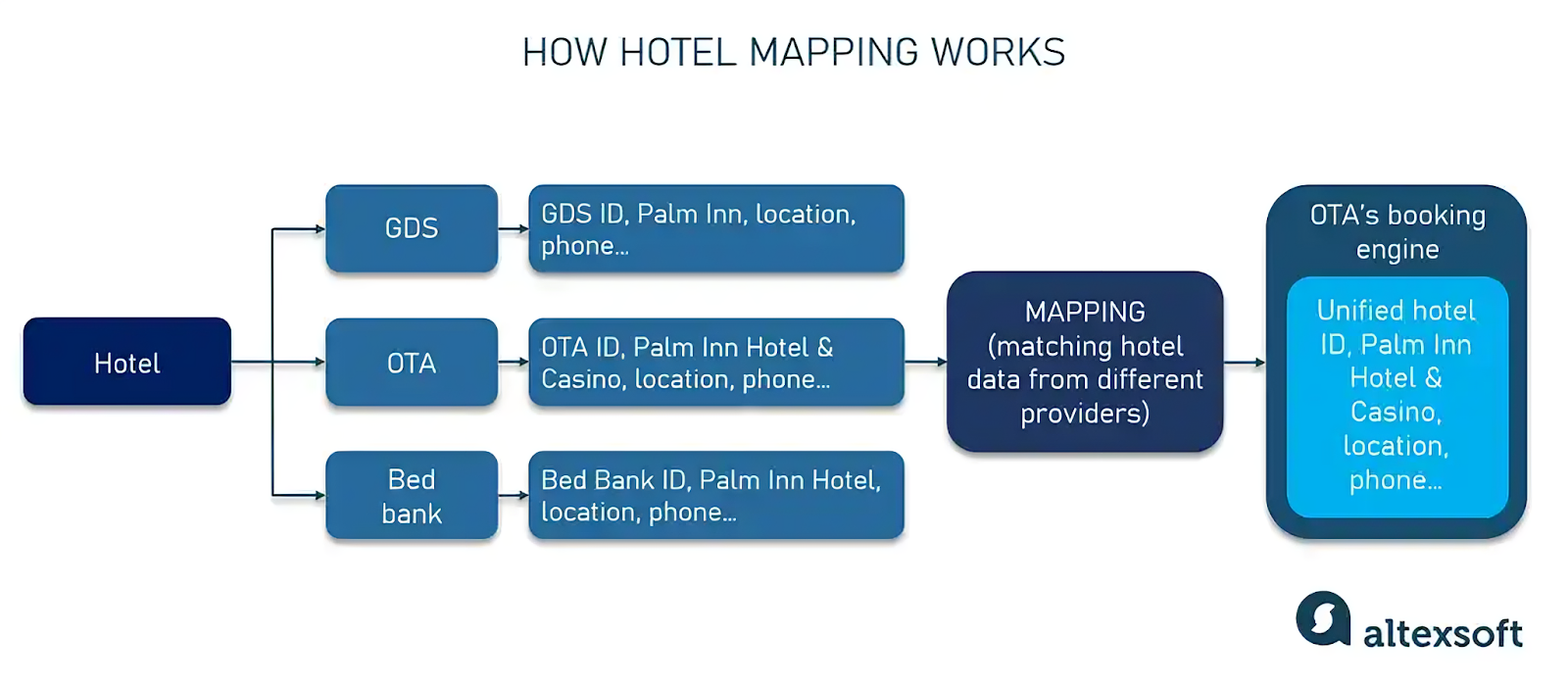
Hotel mapping matches data from different sources and merges the entries under a unified ID
“Mapping hotel IDs does not require frequent updates—once a week or even once a month is typically enough,” Ivan Mosiev explains. “However, room mapping is more dynamic because room categories, descriptions, and availability change more frequently.”
Instead of building a hotel mapping system from scratch (an expensive and time-consuming effort), AltexSoft engineers recommend using third-party hotel mapping tools. For example, Gimmonix requires a single API to connect to multiple suppliers. This means you only need to implement one integration to access a fully mapped hotel database. While Gimmonix ensures high accuracy and reduces development time, it's pricey compared to alternatives.
For more budget-conscious teams, there are solutions like GIATA and Vervotech. Here, developers submit a list of properties or rooms, and in return, the tools generate matching results. “This process is actually not difficult at all,” Ivan Mosiev notes. “These solutions require some additional effort but will save you a lot of money.”
There are situations where developing an internal mapping mechanism is the better approach. Read how our team implemented it when building a luxury vacation rental marketplace.
Integrate with multiple suppliers using a hexagonal architecture
Though it’s obvious that relying on a single supplier is not enough, many booking engines start out with one integration. What you need to keep in mind is that you'll likely add more suppliers as your business grows. That’s why preparing your system for further integrations is crucial.
“I remember a time when an integration with one supplier was done without considering future changes. It led to many issues, such as the need for refactoring and fixing technical debt,” Oleksii Taranets shares. “The main problem was that the business logic and data handlers were tailored to the data structures of a certain provider. When it was time to add new connections, we had to redesign many parts of the system that initially were meant to accommodate only one supplier.”
This misstep demonstrates the importance of considering future additional integrations from the start. Hexagonal architecture helps achieve this flexibility, where you can add or change suppliers without impacting the core of the system. Also known as ports and adapters architecture, it allows you to maintain a clear separation between business logic and external dependencies.
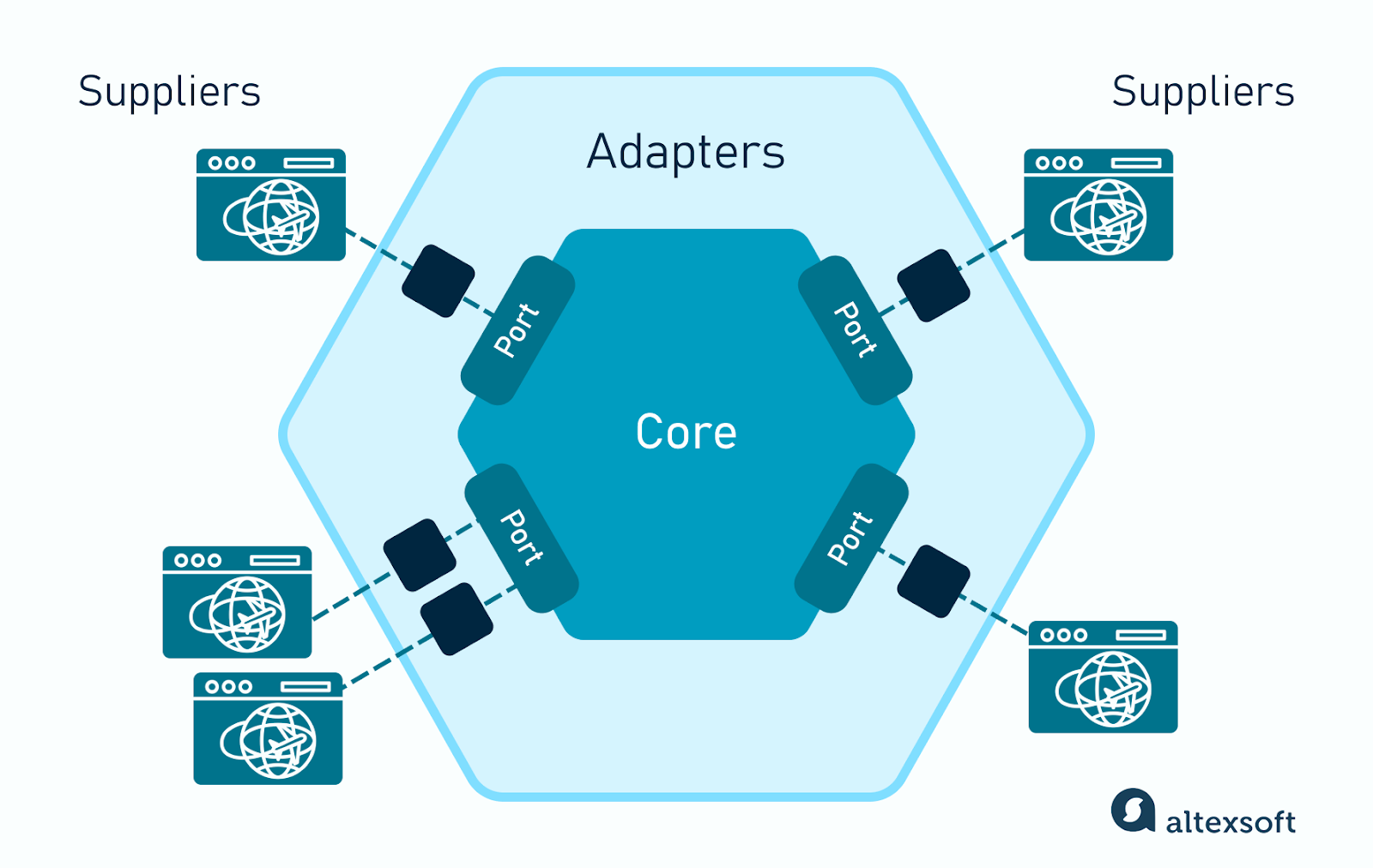
Hexagonal architecture
In a nutshell, here’s how it works. Adapters act as intermediaries that translate external data and requests into a format that aligns with the system's internal requirements. They connect to ports, which define how the core business logic interacts with external systems, ensuring consistency and independence from providers.
For example, if Hotelbeds is the current supplier, a dedicated adapter reformats requests into Hotelbeds API and processes the response accordingly. Should the supplier change in the future, you only need to implement a new adapter without modifying the underlying business logic.
Prioritize autocomplete search results by relevance
While autocomplete may seem like a minor functionality, it plays a significant role in making sure a traveler gets accurate search results. This feature is designed to quickly predict and display the most relevant queries.
As soon as a user starts typing, the system refers to a pre-indexed database—often implemented using a trie data structure, which provides suggestions based on partial input. Tries quickly retrieve strings by using common prefixes. For example, if a user types "New," instead of scanning every possible location for matches, the system narrows the search to entries that share this prefix, such as New York, New Orleans, and Newark.
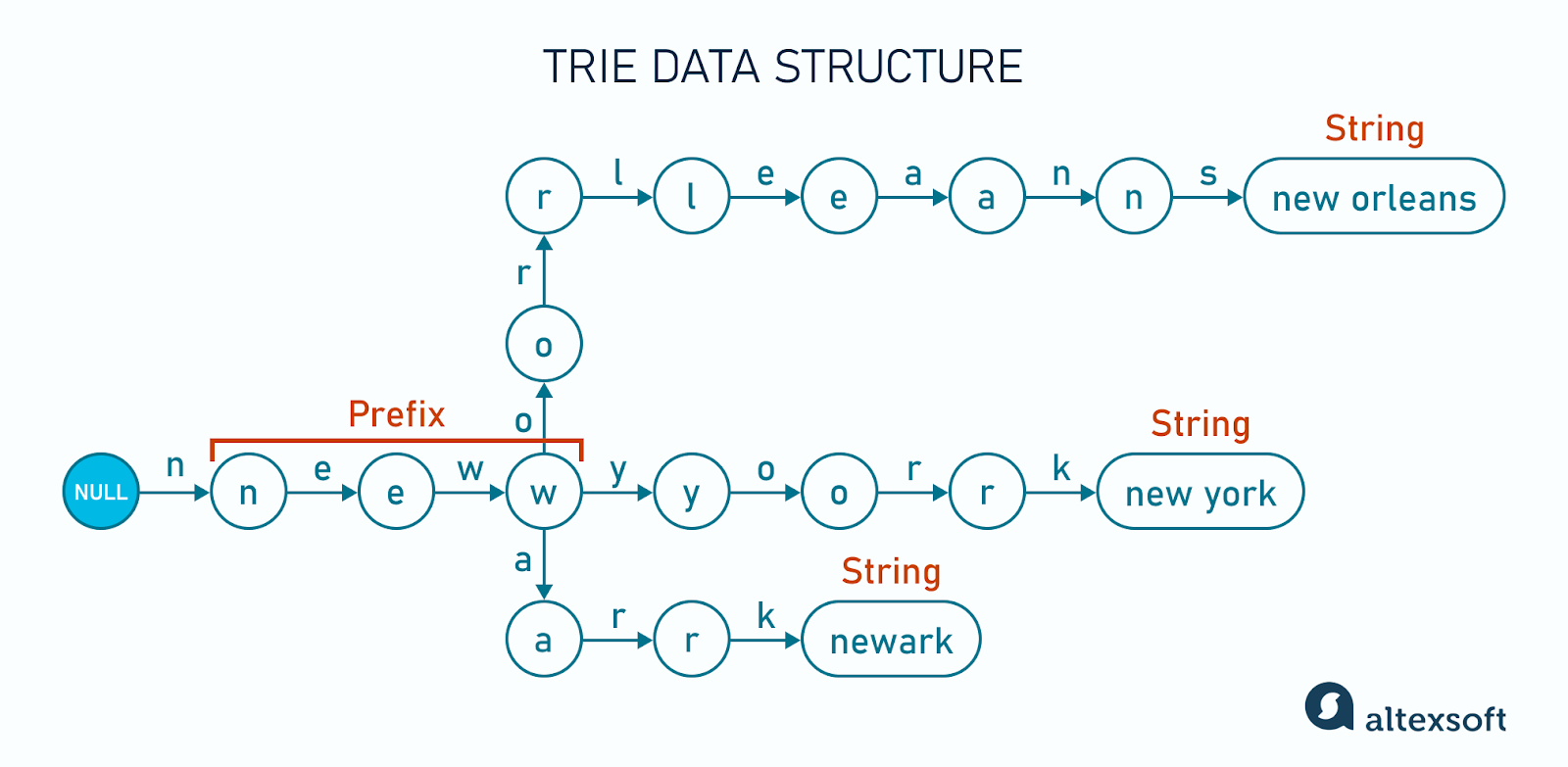
Trie data structure
Like other static content, you get all the suggested names from the providers. Note that these names must also be localized. If users are searching for a destination in a language you don’t provide, then they’ll get irrelevant results, which only creates unnecessary confusion.
Not all autocomplete suggestions should be treated equally. Some options are more relevant than others, and ranking them correctly improves the user experience. "For example, there are two airports in New Orleans, and the system should prioritize the most frequently used one in autocomplete results," Ivan Mosiev explains. "If the less common airport is displayed first, users might accidentally select it and be confused as to why there are so few flight options."
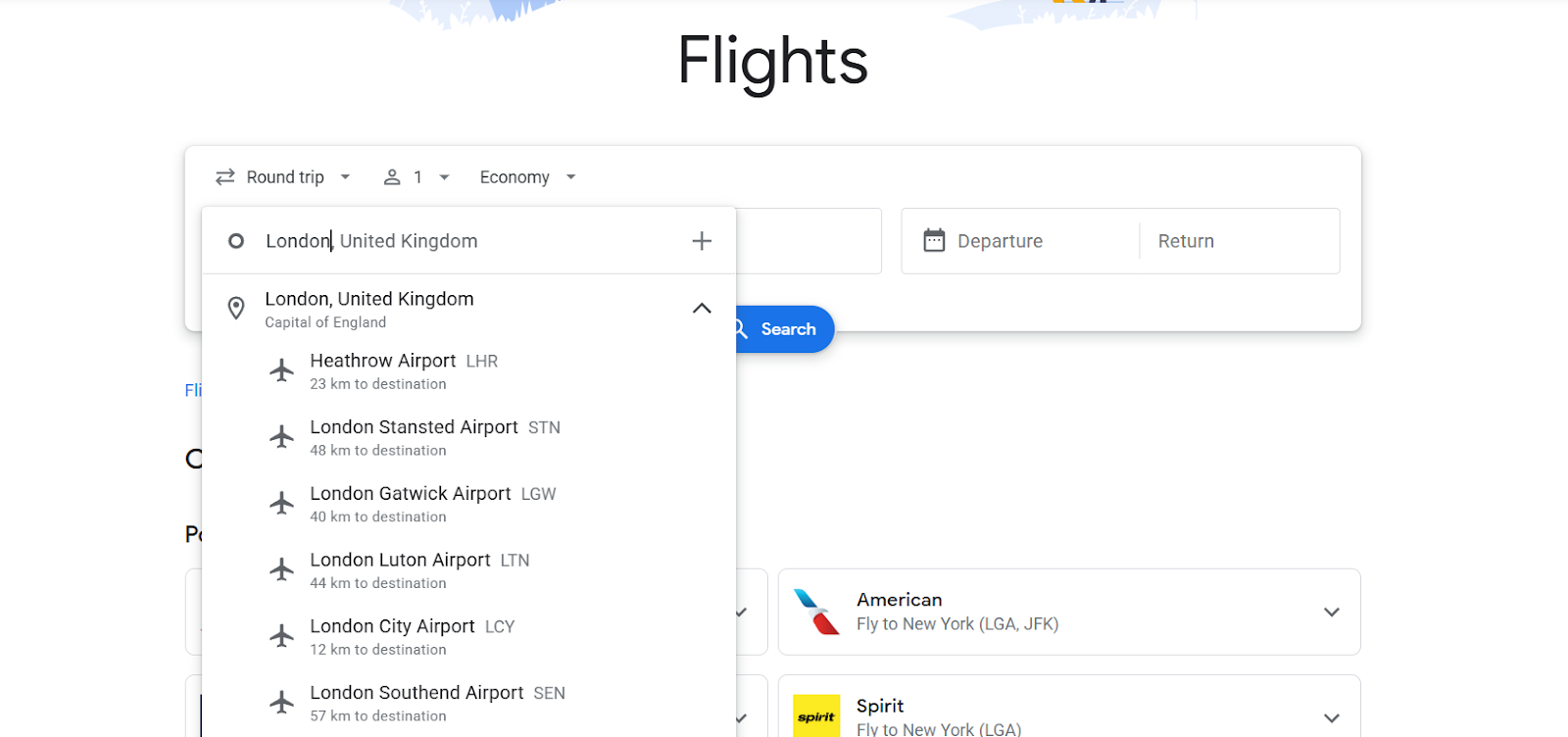
Google Flights displays the most popular airport in London first
Results that are most frequently selected by previous users should receive a higher rank. You can also assign weights based on seasonal trends to prioritize more relevant options.
In addition to search assistance, autocomplete can serve as a marketing tool. For example, if you have partnerships with certain hotels, you can customize autocomplete suggestions and make them appear at the top of the list.
“It is also crucial to ensure that all properties from the user query are included,” Ivan Mosiev adds. “There was a case when a certain accommodation was missing in the dropdown, and the provider was very dissatisfied. This is because they expect full visibility in the booking system, and being excluded can lead to lost revenue.”
Use business metrics to track and improve user experience
Ultimately, the practical advice provided is intended to empower you to build a robust booking engine. However, the work doesn’t stop at deployment, as you need to monitor the performance to ensure your system is delivering real business value.
User engagement is a key indicator that will define the success of your booking engine. Monitoring such metrics from the start is crucial. Otherwise, you risk missing out on optimization opportunities and may be oblivious to where users are struggling or losing interest.
“This aspect is often overlooked at the early stage of the project,” Alexey Taranets shares. “It’s crucial to understand user behavior, and business metrics help with that. They allow you to create a better strategy for improving user experience.”
Let’s look at the key business metrics and what value they deliver.
Look-to-book ratio reflects how many searches or views result in completed bookings. A higher ratio can indicate that users are struggling to find or commit to an option, possibly due to slow response times, irrelevant results, or poor UI/UX.
Click-through rate shows the percentage of search results that receive clicks. If users see results but don’t find them appealing, this could point to irrelevant listings, uncompetitive pricing, or poor presentation (e.g., lack of photos or descriptions).
Time-to-book tracks how long it takes to go from the first search to the completed booking. Long time-to-book often results from slow performance, confusing UI/UX, too many steps, or information overload. Without measuring this, you might not realize how much friction exists in your booking flow.
Returning customer rate is an indicator of customer satisfaction and loyalty. If your booking engine is fast, intuitive, and positively stands out from the competition, users are more likely to come back.
Search refinement rate measures how often users change filters, adjust dates, and modify other search parameters. High refinement rates suggest that initial results aren’t meeting expectations. It can be due to poor default rankings or a lack of personalization.
Conversion rate shows the percentage of users who complete a booking and reflects how well all other metrics work together. Improving conversion rates is the top priority.
Consistent metrics tracking helps meet performance expectations and make targeted improvements that enhance the user experience.
